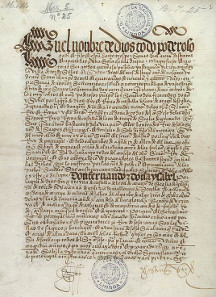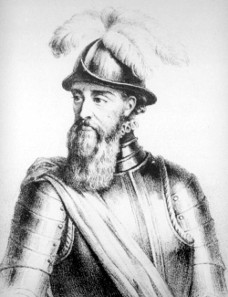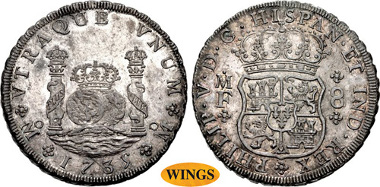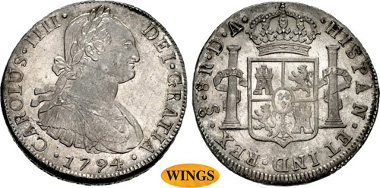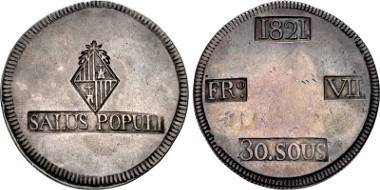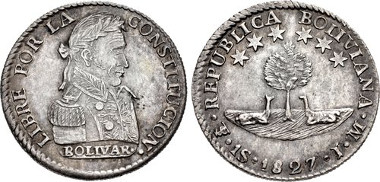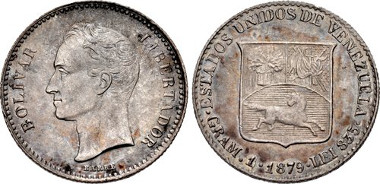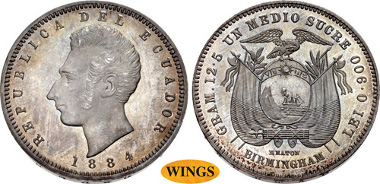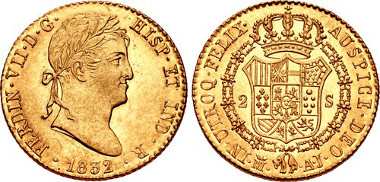By D. Scott VanHorn
The political and numismatic history of Central and South America begins almost immediately after the discovery of San Salvador by Cristóbal Colón (Christopher Columbus) on 12 October 1492.
The Treaty of Tordesillas divided the New World. Source: Wikicommons.
Under the terms of the 1494 Treaty of Tordesillas, which divided the newly-discovered lands outside of Europe between Spain and Portugal along an imaginary north-south line 370 leagues (1184 nautical miles) west of the Cape Verde Islands, Spain was to receive sole control over the New World. Because the terms failed to take into account the location of the continent of South America in relation to the boundary line, the tip of what is modern-day Brazil came under Portuguese control. For this reason, while the rest of Central and South America became part of the Spanish Empire and followed the currency system of Spain, Brazil’s coinage is based on that of Portugal. To control all Spanish exploration and colonization, and to collect import duties and taxes of all goods entering Spain, the Casa y Audiencia de Indias, more commonly known as the Casa de Contratación, was established in Seville.
Plunder of Cartagena by the French in 1544. Source: Wikicommons.
The Spanish colonization of the Americas, sometimes referred to by the Spanish Conquista, involved numerous adventurers, known as conquistadores, and religious missionaries (the Dominicans, Franciscans, and Jesuits), groups that emphasized the primary overseas aims of the Spanish government – conquest of new territory for raw materials, particularly gold and silver, and religious conversion of the local native populations to Christianity (i.e. Roman Catholicism).
Four main expeditionary areas comprise this early period of colonization: Mexico and the Yucatán, Peru, the Río de la Plata and Paraguay, and the Nuevo Reino de Granada. Employing technological advantages (the horse, armor, and the gun), possessing an immunity to European diseases, and manipulating local tribal animosity, the conquistadores were eventually able to overpower and subdue much larger native forces.
Hernán Cortés. Source: Wikicommons.
The conquest of Mexico by Hernán Cortés (1518-1520) is the earliest example of this; with a small force he was able to defeat the Aztec Empire, conquer their capital at Tenochtitlan (modern Mexico City), and imprison their ruler, Motecuhzoma Xocoyotzin (Montezuma).
Francisco Pizarro González. Source. Wikicommons.
In Peru, Francisco Pizarro González began a similar process with his capture of the Sapa Inka Athualpa at the Battle of Cajamarca (1532). Because of the region’s mountainous terrain, it was not until 1572 that the Inca Empire was finally conquered. In 1527, the first Spanish settlement in the Río de la Plata was created with the Fort of the Sancti Spiritu, followed in 1536 by the establishment of Buenos Aires and in 1537, Asunción. Because the site suffered from numerous native attacks, the original site of Buenos Aires was abandoned in 1541; in 1580, the governor of Paraguay, the conquistador Juan de Garay, established a new settlement at the site of the modern-day city.
Finally, between 1537 and 1543, six Spanish expeditions entered the highlands of Colombia. In 1536, the conquistador Gonzalo Jiménez de Quesada defeated the local Chibchas and about 1538 founded the city of Santa Fé de Bogotá and named the surrounding area el nuevo reino de Granada.
Following the conquest of the Aztecs, in 1521 the Virreinato de Nueva España, or the Viceroyalty of New Spain was established. At its greatest extent, it governed Spanish-held territories in the Caribbean and Florida, Mexico and Central America, most of the United States west of the Mississippi and into Canada, and the Philippines. This was followed in 1542 by the creation of the Virreinato del Perú, or Viceroyalty of Peru, which consisted of the continent of South America, with the exception of Brazil. In 1717, the Virreinato de la Nueva Granada was added, and Virreinato del Río de la Plata in 1776. Until the independence movement in the 1820s, it was through this system that the Spanish monarchy governed its overseas possessions in the New World.
The New World territories used the Spanish monetary system of the coinage first instituted by Fernando and Isabella in Medina del Campo in 1497, consisting of silver reales (and its multiples and fractions).
1912: MEXICO, Primera República. 1823-1863. AV 4 Escudos. Ciudad de México mint. Dated 1857/6 Mo GF. KM 381.6. Estimate $6,000.
In 1535, the gold escudo replaced the gold excelente and thenceforth, this became the basis for all the colonial coinage of Spanish America. The discovery of local sources of both gold and silver, particularly the Cerro Rico in Potosí, Bolivia (which provided Spain 41,000 metric tons of silver between 1556 and 1783), necessitated the creation of a number of new mints, not only for local consumption, but also for the export of the quinto real, or crown’s portion, sent back to the Casa de Contratación on the large plate fleets.
The Mexico City mint (established in 1535) was one of the most important of these mints; the other, Potosí (established in 1574), was located at the source of the ore. Later, other mints were established and operated from time to time to handle the discovery and export of the metal.
Until the eighteenth century, hammered coinage was struck. Known as macuquinas, or cobs, these coins became associated with later images of pieces of eight (due to eight reales being cut into pieces for fractions), and pirates on the Spanish Main.
1872: MEXICO, Colonial. Felipe V. King of Spain, second reign, 1724-1746. AR 8 Reales. Ciudad de México mint. Manuel de Léon and Francisco de la Peña y Flores, assayers. Dated 1735 Mo MF. KM 103. The first type of Mexico Pillar struck for circulation. Estimate $3,000.
Following the introduction under Felipe V (1700-1724) of milled coinage, which increased the efficiency of production and provided against clipping or shaving – a process whereby minute traces of the metal might be removed and pocketed as the coinage passed from hand to hand, the coinage of Spain’s New World empire coinage become a medium of international exchange, even after Spain’s former colonies gained independence.
Before issuing their own coinage, the early Republics countermarked existing colonial issues as currency. Even Great Britain, during its coinage shortage of the late eighteenth century circulated both four and eight reales with a counterstamp of King George III. And in the currency-strapped American colonies and United States, the eight reales, or so-called ‘Pillar Dollar’, circulated well into the nineteenth century. Folk etymology attributes the origin of the dollar sign to the filleted pillars in the reales’ design.
1329: CHILE, Colonial. Carlos IV. King of Spain, 1788-1808. AR 8 Reales. Santiago mint. Domingo Eizaguirre and Augustin de Infante y Prado, assayers. Dated 1794 So DA. KM 51. Estimate $5,000.
Napoleon’s invasion of the Iberian Peninsula and the flight of the Portuguese royal family to Brazil in 1807, as well as the events surrounding the abdications of both Spanish monarchs, Carlos IV and Fernando VII between March and May 1808, sparked a number of uprisings in the Spanish America, a situation that was exacerbated by the installation of Joseph Bonaparte as king of Spain, and the Peninsular War (1807/8-1814).
The reasons for these uprisings were varied as not all were driven by the quest for independence. The earliest revolts were the short-lived governing juntas, or popular governments, in Chuquisaca, Bolivia, and Quito, Ecuador.
In Mexico, a similar attempt at independence was made under Miguel Hidalgo, but was soon put down. While those in the Nueva Granada, Venezuela, Chile, and Río de la Plata were more successful, this period was marked by a myriad of these juntas and a great deal of conflict with pro-independence and royalist sides forming up against each other.
921: SPAIN, Reino de España. Fernando VII. Second reign, 1813-1833. AR 30 Sueldos. Provincial issue for the Yslas Baleares (Balearic Islands). Majorca mint. Dated 1821. KM (C) L53.1. Estimate $300.
The restoration of Fernando VII to the Spanish throne in 1813 brought matters to a head. Committed to reinstituting absolutist rule both at home and throughout the empire, Fernando declared those independence movements that had developed during his exile as illegal and began sending troops to quell those areas ‘still in rebellion’. Known as the Reconquista, an allusion to the Reconquista of Medieval Spain, this attempt, while moderately successful in pro-royalist areas, served to coalesce those pro-independence areas into a full-scale counter insurgency; it also precipitated revolts against the Spanish monarchy.
1171: BOLIVIA, Republic. 1825-present. AR Sol. Potosí mint. Juan Palomo y Sierra and Diego Miguel Lopez, assayer. Dated 1827 PTS JM. KM 94; C 52. Estimate $750.
Out of this conflict arose a number of libertadores, popular military leaders who became the principal architects of independence in Central and South America. Among them, Simón Bolívar (1783-1830) became the most prominent. He led Venezuela (together with Antonio José de Sucre), Colombia, Ecuador, Bolivia, and Peru (together with José de San Martín, the libertador of Argentina) to independence, and in 1819 became the first president of the republic of Gran Colombia, a position he held until his death in 1830. These libertadores became the national heroes of the new republics, and became a vital component of the new states’ currency.
2178: VENEZUELA, Republic. 1830-present. AR 1/5 Bolivar. Brussels mint. Dated 1879. Crude letters. KM (Y) 19.1. Estimate $4,000.
To commemorate his achievement in its independence, the Republic of Venezuela in 1879 created the Bolívar, a new currency which, with its multiples and fractions, replaced the old venezolano.
1661: ECUADOR, Republic. 1830-pres. Specimen AR 1/2 Sucre. Heaton (Birmingham) mint. Dated 1884. KM 52. Estimate $3,000.
In Ecuador, the Sucre was established, named for Antonio José de Sucre. Although others adopted more localized names – such as the Peruvian sol, or the Bolivian boliviano – Central and South America’s long-standing economic dependency on Spain compelled them to retain that state’s currency system and denominations, the real and the peso.
1218: BOLIVIA, Republic. 1825-present. AV 8 Escudos. Potosí mint. Fortunato Equivar, assayer. Dated 1852 PTS FP. KM 115. Estimate $10,000.
With the establishment of the Trienio Liberal in Spain, the nascent republics in Central and South America were consolidated and fully independent republics were established. Argentina and Chile, both of which had gained independence in 1818, and Gran Colombia, or the República de Colombia, independent in 1819, were among the first.
none
1892: MEXICO, Primera Imperio Mexicano. Agustín de Iturbide. 1822-1823. AV 4 Escudos. Ciudad de México mint. José Garcia Ansaldo and Joaquin Davila Madrid, assayers. Dated 1823 Mo JM. KM 312. Estimate $6,000.
From 1821 to 1823, Agustín de Iturbide ruled the short-lived Imperio Mexicano, or independent monarchy of Mexico, and between 1823 and 1838/41, the present-day countries of Guatemala, El Salvador, Honduras, Nicaragua, and Costa Rica were joined in the República Federal de Centro América.
By 1825, only a few pockets of royalists remained, carrying on a guerrilla war until 1832.
none
915: SPAIN, Reino de España. Fernando VII. Second reign, 1813-1833. AV 2 Escudos. Madrid mint. Antonio Rafael Narváez and José Duro Carcés, assayers. Dated 1832 M AJ. KM 483.1. Estimate $600.
With the death of Fernando VII in 1833, Spain at last abandoned any hope of military reconquest; in 1836, its government renounced all sovereignty over continental America. During the remainder of the nineteenth century, Spain recognized each of the new states. Only Cuba and Puerto Rico remained under Spanish control until the Spanish-American War in 1898.
These new countries of Central and South America each experienced their own growing pains and trials following independence and continue to do so today (for a more detailed history of each up to the present day, see Leslie Bedell, The Cambridge History of Latin America [Cambridge, 1984-2008]).
This article was written for the catalogue of the Lissner Collection sale auctioned off by CNG. All coins chosen for illustration are being offered in the same auction.
We published an auction preview of the Lissner Collection sale in CoinsWeekly.
You can view the Lissner Collection sale on the CNG website.
There is also available a preview catalogue for world coins …
and a preview catalog for the New World coins.
To browse through the Lissner Collection in the CNG coin shop please click here.



